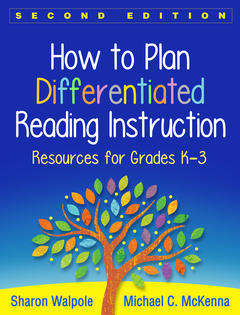Description
How to Plan Differentiated Reading Instruction, Second Edition (2nd Ed.)
Resources for Grades K-3
Solving Problems in the Teaching of Literacy Series
Authors: Walpole Sharon, McKenna Michael C.
Language: English
Subjects for How to Plan Differentiated Reading Instruction, Second...:
62.49 €
In Print (Delivery period: 15 days).
Add to cartPublication date: 08-2022
· 20.3x25.9 cm · Hardback
41.42 €
In Print (Delivery period: 15 days).
Add to cartPublication date: 08-2017
· 20.3x25.9 cm · Paperback
Description
/li>Contents
/li>Readership
/li>Biography
/li>
Tens of thousands of K-3 teachers have relied on this book--now revised and expanded with more than 50% new material--to plan and deliver effective literacy instruction tailored to each student's needs. The authors provide a detailed framework for implementing differentiated small-group instruction over multiweek cycles. Each component of the beginning reading program is addressed--phonological awareness, word recognition, fluency, vocabulary, and comprehension. In a large-size format for easy photocopying, the book includes dozens of reproducible lesson plans, instructional activities, assessment forms, and other tools. Purchasers get access to a webpage where they can download and print the reproducible materials.
New in 2024: An online-only Study Guide by Sharon Walpole presents commentary and discussion questions for each chapter from a science-of-reading perspective--available for download at www.guilford.com/walpole-studyguide.
New to This Edition
*Differentiation 2.0: the approach has been fine-tuned based on field testing, new research findings, and current standards and response-to-intervention frameworks.
*Many additional reproducible tools, such as coaching templates and the Informal Decoding Inventory.
*Beyond lesson plans and materials, the second edition offers more guidance for designing instruction and grouping students, making it a one-stop resource.
*Reproducible tools now available to download and print.
An NCTQ Exemplary Text for Reading Instruction
1. Setting the Stage
2. Models of Differentiation and Tiered Instruction
3. Using Assessments to Guide Differentiation
4. Targeting Phonological Awareness and Word Recognition
5. Targeting Word Recognition and Fluency
6. Targeting Fluency and Comprehension
7. Targeting Vocabulary and Comprehension
8. Making Differentiation Schoolwide
Sharon Walpole, PhD, is Professor in the School of Education at the University of Delaware. She has extensive school-based experience designing and implementing tiered instructional programs. Dr. Walpole has also been involved in federally funded and other schoolwide reform projects. Her current work involves the design and effects of schoolwide reforms. She has coauthored or coedited several books, including How to Plan Differentiated Reading Instruction, Second Edition: Resources for Grades K-3; The Literacy Coach’s Handbook, Second Edition; and Organizing the Early Literacy Classroom. Dr. Walpole is also Series Editor, with Michael C. McKenna, of The Essential Library of PreK-2 Literacy. She is a recipient of the Early Career Award for Significant Contributions to Literacy Research and Education from the Literacy Research Association and the Excellence in Teaching Award from the University of Delaware.
Michael C. McKenna, PhD, was Thomas G. Jewell Professor of Reading in the School of Education and Human Development at the University of Virginia until his death in 2016. He authored, coauthored, or edited more than 20 books and over 100 articles, chapters, and technical reports on a range of literacy topics. Dr. McKenna also served as Series Editor, with Sharon Walpole, of The Essential Library of PreK-2 Literacy. His research was sponsored by the National Reading Research Center and the Center for the Improvement of Early Reading Achievement. He was a corecipient of the Edward B. Fry Book Award from the Literacy Research Association and the Award for Outstanding Academic Books from the American Library Association, and a member of the Reading Hall of Fame.




